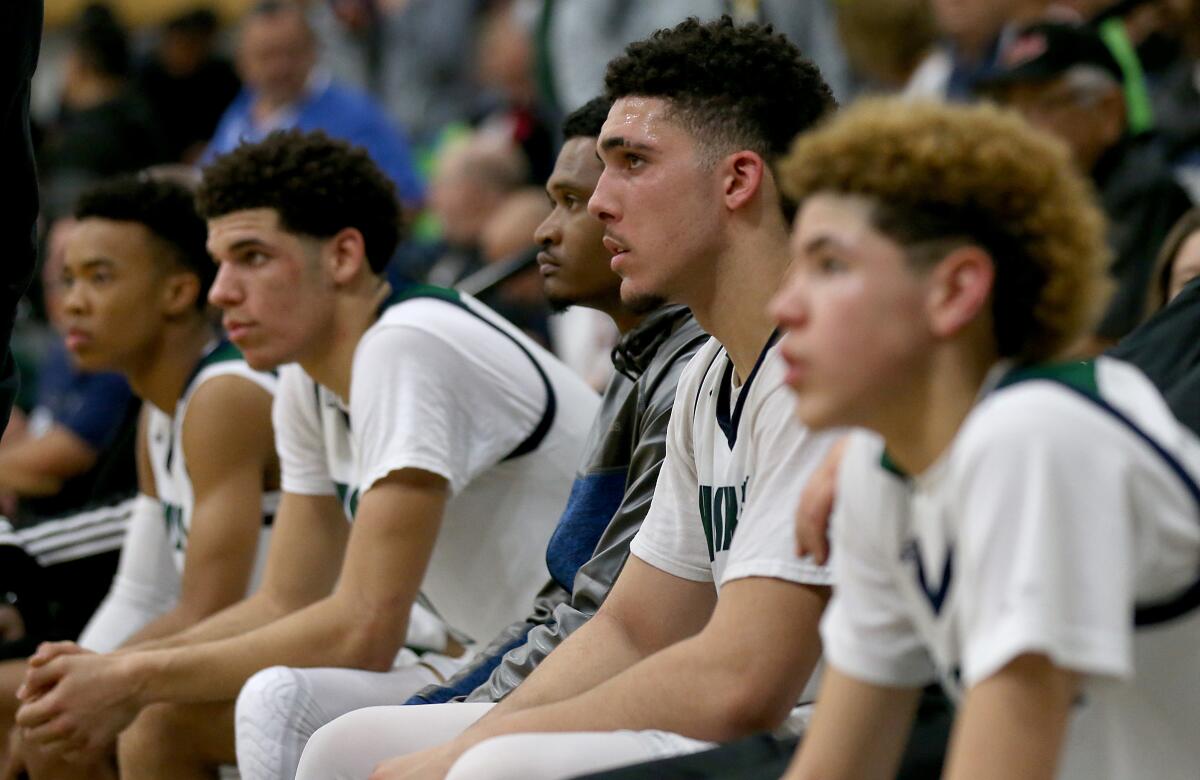Prep Rally: Ten years ago, the Ball brothers were the greatest show in high school basketball
Hi, and welcome to another edition of Prep Rally. My name is Eric Sondheimer. It’s championship week in high school football. It’s also the 10-year anniversary of one of best and most entertaining high school basketball teams in history — the unbeaten 2015-16 Chino Hills Huskies, led by the Ball brothers
Looking back at greatness

LiAngelo Ball, center, is flanked by his brothers Lonzo, second from left, and LaMelo in 2016.
(Los Angeles Times)
High school basketball fans, sportswriters and coaches had the time of their lives watching the creation of Chino Hills’ 35-0 team from 2015, with brothers Lonzo, LiAngelo and LaMelo Ball in starring roles. They helped entertain and draw so many Oohs and Aahs that they became nationally recognized, along with their always talkative father, LaVar.
The tales of showing up with a lawn chair two hours before a game to make sure you got a seat before the gym sold out are legendary. The talent and chemistry of the Balls, along with Onyeka Okongwu and Eli Scott, was something to behold all the way to Chino Hills winning the state championship in March of 2016 in Sacramento.
Here’s a look back from a sportswriter’s perspective and that of the head coach, Steve Baik.

Keawe Browne (2) celebrates after a blocked Mater Dei field-goal attempt gives Corona Centennial 28-27 win.
(Craig Weston)
Who had Santa Margarita facing Corona Centennial in Friday’s Southern Section Division 1 final at the Rose Bowl? Both teams earned the spot, the first time St. John Bosco or Mater Dei have failed to participate in the championship game since 2012.
Here’s how Centennial beat Mater Dei 28-27 in the semifinals with a blocked field goal at the end of the game.
Santa Margarita took care of business in the other semifinal to defeat Orange Lutheran. The Eagles are surging because of their terrific defense and the threat Trent Mosley offers any time he touches the ball. Here’s the report.
Here’s a look at how Santa Margarita and Centennial cracked the code to create a new championship game.
In Division 2, two league rivals, Los Alamitos and San Clemente, will play for a second time this season on Saturday night at San Clemente.
Here’s this weekend’s championship schedule.
Here’s a look at the top individual performances from last week.
Crenshaw pulled off the win that few expected when the City Section season began last August. The Cougars handed Birmingham its first defeat after 55 consecutive wins over City opponents 12-7 in the City Open Division semifinals. What a coaching job by interim coach Terrence Whitehead. His team will face Carson for the City title on Saturday at L.A. Southwest College. Here’s a look at Crenshaw’s journey this season.

Carson first-year coach William Lowe has his team trying for a 12th City title.
(Nick Koza)
Carson is playing like a No. 1 seed after dominating Garfield in the semifinals. With quarterback Chris Fields’ ability to run or pass, the Colts will have an advantage against a Crenshaw team that hasn’t faced many teams with balanced offenses.

South Gate quarterback Michael Gonzalez tries to console William Smith of Dorsey in an act of sportsmanship after South Gate win.
(Nick Koza)
In Division I, South Gate will take on Marquez on Saturday. South Gate defeated Dorsey in its semifinal and Marquez toppled top-seeded Venice. Here’s a look at South Gate players showing sportsmanship after their game. Dorsey had to play on Monday after playoff game against Eagle Rock had a power blackout. Here’s a look at the Dons’ win.
In Division II, Cleveland rallied for a win over Fairfax and will face San Fernando. Here’s a report. In Division III, Hawkins will play Santee.
Basketball

Brandon McCoy of Sierra Canyon had nine dunks and 25 points in win over JSerra.
(Craig Weston)
The Trinity-Mission League Challenge at Pauley Pavilion produced lots of dunks and competitive games. The best game ended up being the last, with St. John Bosco beating Harvard-Westlake 57-55. Santa Margarita rallied for a 77-73 win over Sherman Oaks Notre Dame behind 28 points from Brayden Kyman. Brandon McCoy had nine dunks in his Sierra Canyon debut, a win over JSerra.
Here’s a look at the games and top performances.
Here’s this week’s top 25 rankings by The Times.
In girls basketball, defending Southern Section Open Division champion Ontarior Christian started with two wins and Kaleena Smith scoring 45 and 35 points.
Redondo Union is hosting a tournament beginning Monday that includes Etiwanda.
Harvard-Westlake unveiled freshman Lucia Khamenia, the sister of Nikolas. Here’s a report.
Legacy of the Kymans

Brayden Kyman of Santa Margarita.
(Eric Sondheimer / Los Angeles Times)
The Kymans have been a sports family for years. Bernie Kyman was a coach and athletic direct. Son Coley starred in football and volleyball at Reseda and Cal State Northridge. His son Jake won a CIF title at Santa Margarita before playing for UCLA basketball.
Now Brayden is a senior basketball player at Santa Margarita. The family is moving to Montana after this season. A look at the impact and legacy of the Kymans.
Girls tennis

The Calabasas High girls tennis team won the Southern Section Division 2 championship.
(Courtesy Calabasas High)
Corona del Mar completed an unbeaten Southern Section girls tennis season with a victory over Portola in the Division 1 championship match. Here’s a report.
Calabasas defeated Harvard-Westlake for the Division 2 title. Here’s a report.

Alexa Guerrero holds the championship plaque as she and her Marshall teammates celebrate their City Section Open Division flag football championship win over Eagle Rock.
(Steve Galluzzo / For The Times)
Marshall has climbed to the top in City Section flag football with a 20-0 win over Eagle Rock in the Open Division final.
Here’s a look at the newest City champions.
Cross country

Irvine senior Summer Wilson won the Southern Section Division 2 cross-country title.
(Steve Galluzzo / For The Times)
On the rain course at Mount San Antonio College, Summer Wilson ran away with the Division 2 championship at the Southern Section cross-country championships. Here’s the report.
The City championships were held at Elysian Park, and Palisades won boys and girls titles. Here’s the report.
The state championships will be held Saturday at Woodward Park in Fresno.
Girls volleyball
Mater Dei, Harvard-Westlake and Cypress won state championships in girls volleyball.
Here’s the report.
Notes . . .
Justin Utupo is out after one season as football coach at Long Beach Poly. The Jackrabbits (5-5) lost six players to ineligibility by the Southern Section and the school administration refused to allow the team to participate in the playoffs. The program has won 20 Southern Section football championships but last won a Division 1 title in 2012 under Raul Lara. Here’s the report. . . .
Aaron Huerta has resigned after one season as football coach at Bishop Alemany. . ..
The CIF state championship football games will be played Dec. 11-12 at Buena Park High, Fullerton High and Saddleback College. . . .
Bo Beatty, the co-head football coach at Bonita, has resigned to return to Azusa Pacific where he was a long-time assistant coach. Steve Bogan is the co-head coach. . . .
Defensive lineman James Moffat of Crespi has committed to UCLA. . . .
Santa Margarita won its third state title in girls golf at Poppy Hills Golf Course. . . .
It was the year of Newport Harbor in boys water polo. The team lost one match all season and avenged its only defeat with a win over Cathedral Catholic in the regional final. . . .
Kacey Norwood has been named interim girls’ lacrosse coach at St. Margaret’s. . . .
JD Hill, a defensive lineman at Mission Viejo, has committed to Washington. . . .
Cooper Javorsky, a lineman from San Juan Hills who decommitted as a UCLA recruit after the firing of DeShaun Foster, has recommitted to the Bruins. . . .
From the archives: Carson Schwesinger

Former Oaks Christian and UCLA linebacker Carson Schwesinger.
(Damian Dovarganes / Associated Press)
Former Oaks Christian and UCLA linebacker Carson Schwesinger is having a successful rookie season for the Cleveland Browns. After being selected No. 33 overall in the NFL draft, he’s been starting and earning rave reviews.
He went to UCLA as a walk-on and became a star.
Here’s a story from 2021 on Schwesinger walking on at UCLA.
Recommendations
From the Washington Post, a story on a high school football lineman who didn’t know how to put on pads three years ago and became an Oregon recruit.
From the San Diego Union-Tribune, a look at the top high school basketball teams in San Diego.
From NFHS.org, a story of sportsmanship across the country in high school sports.
From the Las Vegas Review Journal, a story on changes in Nevada’s football playoff system that will allow Bishop Gorman only one nonleague game starting in 2026.
Tweets you might have missed
Until next time….
Have a question, comment or something you’d like to see in a future Prep Rally newsletter? Email me at [email protected], and follow me on Twitter at @latsondheimer.
Did you get this newsletter forwarded to you? To sign up and get it in your inbox, click here.

